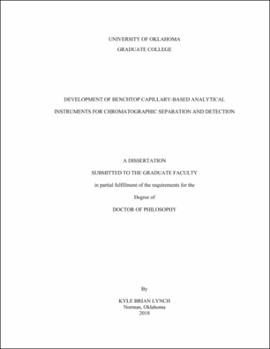| dc.description.abstract | Point-of-Care (POC) analysis in recent years has driven the need for the miniaturization of chemistry instruments in the analytical field. One such instrument class involves chromatographic systems for the separation and detection of complex samples. From this need, micro Total Analytical Systems (microTAS) as well as Lab-on-Chip (LOC) systems have been developed. These systems allow for the potential of cost reduction in manufacturing as well as on-site analysis. One method to obtain a significant size reduction in the instruments is to transition all liquid flow to a capillary-based system. Within this dissertation we show that through the minimization of the liquid channels, new portable separation and detection systems can be developed.
In the second chapter, we describe the development of a high-performance liquid chromatography (HPLC) capillary-based cartridge for complex separations. HPLC has traditionally required the need for high-pressure piston pumps that are inherently large in size. In order to mitigate this issue, we have developed and reported monolithic capillary-based electroosmotic pumps (EOPs) capable of producing an output pressure greater than 1200 bar. EOPs are proving to be a promising alternative to traditional piston pumps and can be applied to either capillary or chip-based systems. Within our HPLC cartridge, we develop a novel valve system capable of providing gradient elution and nanovolume injection (Figure 2-1). A two-loop system allowed dual EOP units to drive a gradient separation while refilling the second loop for subsequent column reconditioning. When the valve is switched and reconditioning begins, the gradient profile can be regenerated for the next separation.
In the third chapter, a narrow capillary benchtop laser induced fluorescence detector is developed. Currently, low- and sub-micrometer capillary systems capable of on-column detection are not commercially available. Through the development of this confocal LIF detector prototype, we were able to characterize its limitations including the limit of detection (LOD), linear dynamic range (LDR), and background drift through a flow injection analysis (FIA) system within a 2-um-i.d. capillary. We obtained a very low LOD of around ~70 fluorescein molecules (equating to a 12 yoctomole fluorescein LOD). A wide LDR was reported at three orders of magnitude while a 1.2-fold root-mean-square (rms) noise was obtained. Following the characterization, a DNA ladder sample was separated by bare narrow capillary-hydrodynamic chromatography (BaNC-HDC). Through this testing, we were able to further demonstrate the feasibility of the system by obtaining both well-resolved peaks as well as quantitative information for the DNA fragments.
In the fourth chapter, we describe the development of a multiple channel UV/Vis optical fiber-based absorbance detector for high throughput screening of chromatographic separations. There has been increasing interest in online comprehensive two-dimensional liquid chromatography (2D-LC) systems. These systems allow for a high peak resolution of complex samples that traditional one-dimensional liquid chromatography could not provide. However, current configurations of commercial 2D-LC systems involve two or more columns with two detectors and provide separation times in the tens of hours. In order to shorten the total separation time, a novel configuration for 2D-LC was developed and the detector for said system is presented here. The detector consists of four major components: a deuterium lighthouse; an optical fiber module assembly; a 13-channel flow cell fitted with a 13-photodiode detection system; and a data acquisition and monitoring terminal. When characterizing the detector, we were able to obtain background noise level in the tens of µAU and a linear range of ~2.5 AU. | en_US |
